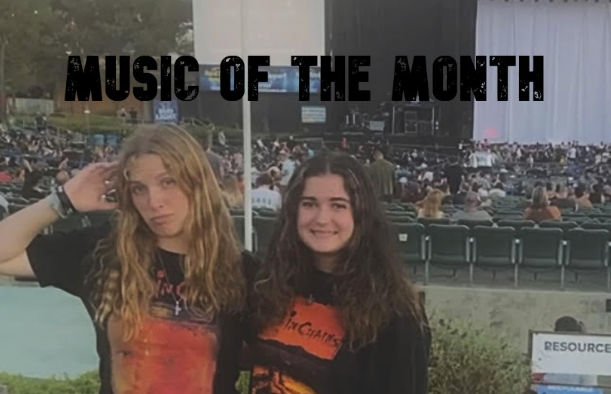Music of the Month: September
A look at our top songs for the month of September.
Cali and Brianna compile a list of their top songs each month and go in depth with them.
October 11, 2022
Happy September! Musically, this has been an eventful month for us, as we saw Bush, Breaking Benjamin, and Alice In Chains in concert on Sept. 7. Also taking place this month were two tribute shows that paid homage to the late, great Foo Fighters drummer Taylor Hawkins (we wish we could’ve gone!). We continued to listen to our favorite songs as well as expand our music knowledge by introducing new artists to one another. Enjoy!
Cali’s Picks
“Pitseleh” by Elliott Smith, “XO” (1998)

Roughly translating to “little one” in Yiddish, “Pitseleh” is a peaceful tune on Elliott Smith’s fourth studio album, “XO”. The song begins with a light acoustic guitar soon followed by Smith’s transcendental vocal introduction. Like many of Smith’s songs, the melodic track is completely acoustic and embodies themes of unrequited love and a supposed breakup. In each verse, Smith’s lyrics and guitar encompass a sense of tranquility as these sections flawlessly flow into the next. Without an official chorus, “Pitseleh” contains three main verse segments and a moving instrumental bridge that includes a slight chord change and a fitting piano accompaniment. Before the calming outro, Smith concludes the final verse with the emotive line, “I never meant to hurt you.” This continues to express the themes of a relationship ending, but it also nicely fits as the last line of the song, as it emits a sense of closure. Through and through, the song gives the listener’s ears a warm hug through the moving lyrics, cooed vocals, and soothing instrumentals.
“Procreation (Of the Wicked)” by Sepultura, “Procreation…of the Wicked!!!” (1997)

Originally by Swiss metal band Celtic Frost, Sepultura put their own dissonant twist on the track through the dizzyingly heavy guitars, driving drums, and growling vocals. Following the success of their 1996 album, “Roots”, the Brazilian metal outfit released a three-song EP (extended play) that contained this eponymous track. “Procreation” kicks off with a small burst of feedback, a short scream, and a muffled guitar glissando that then drifts into the hard, yet surprisingly groovy, pre-verse section. The verses are somewhat void of guitar, and are strengthened by the beautifully scratchy vocals and loud drums. The choruses directly follow the verses and are bridged together by small segments of sludgy instrumentation. After the second chorus and a lengthy vocal callout, lead guitarist Andreas Kisser breaks away into a sporadic and evocative guitar solo that continues the chaotic vibe of the number. After a bridge that confronts topics of love, hate, and death, the band immerses itself into another instrumental break filled with an audible bass, squealing guitars, and an alternate form of percussion found in the bongos. This fragment is only broken by vocalist and guitarist Max Cavalera’s spine-chilling scream that returns the composition to the main riff and chorus. The harrowing track ends in a warped-sounding vocal growl that carries on for a near 15 seconds before being cut off. Cavalera shines throughout this track with his brutal and raw vocal yells and snarls that greatly impressed his bandmates during the creation of this number. Although this tune keeps many components of the original, it expresses Sepultura’s adaptability and potential to infuse sounds that reflect their Brazilian and Latin heritage.
“Scared” by Albert Hammond Jr., “Yours to Keep” (2006)

The eighth track on Albert Hammond Jr.’s fan-favorite solo debut album, “Scared” expresses the many styles and facades present in the mind of The Strokes’ guitarist. Famously known as the son of a notable folk star (who he derives his name from), an innovative guitarist, and founding member of The Strokes, Hammond Jr. came into his own with the release of his debut solo album, “Yours to Keep” in 2006. The dreamy number begins with a muffled sound that resembles a vinyl record scratching that then carries on to the blissfully muted guitar riff. The verses of the composition awaken a somewhat melancholic feeling within the listener through the thought-provoking lyrics, staccato riffs, and Hammond Jr.’s appeasing voice. The chorus swings into an even mellower vibe with the introduction of an acoustic guitar and Hammond Jr.’s almost whispered vocals. Following the second chorus, the song breaks into a hypnotic bridge riddled with delayed guitar pieces, snappy guitar riffs, jazzy bass lines, and percussive sounds. The final chorus slightly contrasts to the other reprises, as harmonizing background vocals accompany Hammond Jr., and the lackadaisical section is repeated twice. The track ends with a trippy acoustic and lead guitar piece, the final resonance of a piano chord, and a return of the scratching heard in the beginning. This song shows Hammond’s creative and musical prowess that often hides itself in The Strokes.
“Nebula” by Incubus, “S.C.I.E.N.C.E.” (1997)

A deep cut from Incubus’ second studio album that pioneered nu metal and experimental forms of hard rock, “Nebula” is a track that is musically and structurally scatterbrained. As standard for early Incubus works, this track begins with a somewhat warped vocal sample that is quickly joined by a rolling drumline and guitar feedback. The verses are vaguely quiet, but quickly transition into the heavy and loud choruses that highlight Jose Pasillas’ outstanding drumwork, Brandon Boyd’s vast vocal range, and Mike Einziger’s quick and successive guitar riffs. Each chorus and verse are bridged together by a rapid-fire of Boyd’s vocals, as well as an odd assortment of riffs, feedback, mechanical sounds, and screams. The second verse slightly differs from the first as Boyd and Einziger harmonize, while turntablist Gavin Koppel adds a variety of noses into the background. Following the second chorus, Einziger begins playing a tremolo-picked riff that almost sounds sped up that switches between bellowingly low vocal samples. After this peculiar bridge section, the number begins its breakdown with booming snares, hard riffs, and Boyd’s distorted laughs. The breakdown fades right into the third and final chorus that then drifts into the climactic and spontaneous outro that is filled with feedback, turntable scratches, and out-of-time drum beats. The innovative styles and techniques that Incubus incorporate into their sound showcase their wide range of influences. However, these virtuosic styles went on to impact seminal 2000s hard rock bands such as Linkin Park, Coal Chamber, and Static-X.
“My Name Is Mud” by Primus, “Pork Soda” (1993)

The first single from Primus’ third album “Pork Soda”, “My Name is Mud” is an interesting, seemingly genreless song that has become a staple and fan-favorite in the band’s song catalog. Delivered by a comically unclassifiable band, this song could only be described as a tortured country tune with a metal spin on it. Although the protagonist featured in the lyrics is named Mud, the title is a play on the phrase “your name is mud”, which dates back to the assassination of Abraham Lincoln. Like many Primus songs, this track is predominantly filled with the curious sounds of Les Claypool’s fretless bass and country-esque vocals; that are accompanied by random guitar licks and segments of double-bass drums. The song begins with a heavy bass lick that boosts into a fuzzy symphony of rhythmic drums and bended guitar sections. The verses are absent of guitar, but show the prowess of Les Claypool and Tim Alexander’s psychobilly rhythm section. Ler LaLonde’s avant-garde guitar playing returns during the chorus as he plays a grimy and wah-soaked solo that continues until the next verse. After the second chorus, the band begins playing a brief instrumental section that is broken up by the line, “‘Where you goin’ city boy?’” that is a derivative from the 1972 film, Deliverance. After this small interruption, the band breaks into the extremely melodic outro that continues until the closing guitar harmonics. This track helped boost Primus’ popularity, as well as their album “Pork Soda” to skyrocket to one million sales and number seven on the US Billboard Charts.
Honorable Mentions:
“Dead Souls” by Joy Division, “Still” (1980)

Recorded before the death of lead singer Ian Curtis, but released posthumously, “Dead Souls” is an eclectic look into the mind of the late singer. Made famous through a Nine Inch Nails cover, this track combines complex chords with all-too-real lyrics that became a theme for many Joy Division songs; as well as those influenced by them.
“Anthem” by blink-182, “Enema of the State” (1999)

The epic closing track on blink-182’s breakthrough fourth studio album, “Anthem” is a reminiscent song that simply ebbs and flows with unbridled youth energy. Although sometimes overshadowed by Tom DeLogne’s prominent vocals and punk-like guitar playing, the true shining star of this composition is drummer Travis Barker as he absolutely annihilates his drum kit throughout the song. blink-182 provides a nostalgic overview of the course of their teenage years that perfectly encapsulates the themes of their album in order to appropriately end it.
“Art School” by Remo Drive, “Greatest Hits” (2017)

Beginning with deafening feedback, “Art School” sets the tone as the opening song on Remo Drive’s unique debut album, “Greatest Hits”. The track is greatly driven by Erik Paulson’s hard-hitting guitar riffs and Sam Becht’s pounding drums. Although the bulk of the track is greatly loud and energetic, the outro is a quiet instrumental buildup that eventually fades into silence.
Brianna’s Picks
“Soul Suckin’ Jerk” by Beck, “Mellow Gold” (1994)

A track that is a staple on the eccentric and hybrid genre album “Mellow Gold”, “Soul Suckin’ Jerk” incorporates styles of rap, alternative, and noise music throughout the fifth track. The song commences straight into the verses rap-style lyricism on top of the prominent drums and bass-driven instrumentation. Behind the verse, a dull metal detector effect can be heard, panning left and right. Beck utilizes overlaid vocals by providing various pitches for the vocals and chorus. Regarding the chorus, Beck sings about a person who doesn’t want to work and detests their boss through the extremely catchy refrain. With an emphasis on the mid and low tones, Beck’s falsettos are only audible towards the end of each line in the first verse and following the second chorus; however, the high tones are still buried below the former. Subsequent to the first chorus and folk-like guitar solo, the use of noise rock begins to surface with its timbre resembling the feedback of a megaphone. This effect remains relevant through the next verse and chorus. Over the duration of the track, the vocals and overall production become more chaotic and tumultuous through the unorthodox-like sound effects (in relation to mainstream music). With intense feedback, distorted bass, and background vocals, Beck introduces an electronic noise between the second verse and an accordion behind the last chorus. To provide some relief during the overwhelming commotion, Beck briefly stops the instrumentation to rap the abnormal line “And she’s coming after me with a butterfly net”. After the final instrumental section prior to the outro, the production includes boisterous effects of gargling vocals and intricate drumming. In the outro, the feedback sound is replaced with a computer and digital-like effect; bringing out the avant-garde side, evident throughout the album. The track ultimately drains with a robotic vocal outro of the chorus.
“30 Minute Boyfriend” by Julian Casablancas, “Phrazes for the Young” (2009)

On the debut solo album of vocalist Julian Casablancas from the Strokes and the Voidz, “30 Minute Boyfriend” highlights Casablancas’ incredible and underrated range. The track commences with a deep-toned synthesizer that mimics a standard bass and subtle orchestration and remains constant throughout. Following the brief synth intro, Casablancas incorporates smokey vocals with his candid narration. Notably, the first line of the opening chorus, “Will you become what other people think of you?”, opens a conversation of an individual conforming to social norms. For the second chorus, Casablancas seamlessly switches between the former and latter half of the chorus. With this futuristic pop synth track, Casablancas’s stentorian and silvery voice is more evidently apparent in the secondary verse as opposed to the crooning voice of the initial verses. Before the second chorus, a brief bridge is detectable but is soft-spoken; compared to the track’s insistent vocals. Concluding the track, Casablancas vocalize with sustained, modulated falsettos that become (in a way) a part of the multi-layered synths. Briefly pausing the vocalize, Casablancas’ resonant vocals become buried underneath the instrumental. Throughout the duration song, Casablancas exhibits his exceptional range through the consecutive switching between the low and high notes of the track.
“Stereo” by Pavement, “Brighten the Corners” (1997)

Inspired by the lyricism of Beck, “Stereo” kicks off Pavement’s fourth studio album with an oscillate panning bass courtesy of Mark Ibold and sporadic guitar. The guitar of the track is only coherent during the choruses; the instrumental breaks, the latter half of the second verse, and the final verse. Formed in Stockton, California in 1989, lead singer and predominant songwriter Stephen Malkmus utilizes a high rising terminal inflection and vocal fry which adds emphasis to the last part of a line. With the juvenile-like attitude and out-of-the-box lyrics, Malkmus includes a similar tone through the track’s lyrics, such as “Wave to the camera/ It took a giant ramrod”. This specific lyric’s melody is sampled from the children’s nursery rhyme “Ring around the Rosie”. “Stereo” also features another reference to Rush’s lead singer Geddy Lee through the lines of the second verse “What about the voice of Geddy Lee? How did it get so high? I wonder if he speaks like an ordinary guy? I know him and he does!” This track is very dynamic with the numerous guitar tones and feedback.
“Big Take Over” by John Frusciante, “Niandra LaDes & Usually Just a T-shirt” (1994)

The fourth track on renowned guitarist John Frusciante’s debut solo album, “Big Take Over” is the only track not written by Frusciante. Originally composed by punk rock band Bad Brains, the “Niandra LaDes” version is slowed and sung melodically compared to its counterpart. Because this track is a cover of an already existing song, “Big Take Over” is by far the most accessible song for listeners on the exceedingly avant-garde and experimental LP. During this time in his life and music career, Frusciante left Red Hot Chili Peppers after their newfound fame from “Blood Sugar Sex Magik”. This record is an inside look at the environment Frusciante was in through his desire to create music outside the mainstream standard. Frusciante turned to heroin as a way to create the most authentic kind of art. This method caused him to become more and more reliant on drugs which resulted in an extreme decrease in his health. Like the other tracks on “Niandra”, Frusciante recorded this song on a four-track recorder; most of them being recorded during the “Blood Sugar Sex Magik” sessions. Layering over his typical use of guitar, Frusciante incorporates a mandolin in the track which highly contrasts the tone within the Bad Brains version. Unlike the majority of the tracks, Frusciante opts out of the use of a voice filter; making this track stand out even more. By including other instruments on the record, Frusciante navigates through a new journey of self-discovery by slightly steering away from the guitar that fans were accustomed to hearing him play.
“Juicebox” by The Strokes, “First Impressions of Earth” (2005)

Following the success of their debut album “Is This It”, The Strokes released the first single of their third album “First Impressions”. The track detonates into a bass-prominent rhythm provided by Nikolai Fraiture. The thunderous bass tone is laden with Fabrizio Moretti’s progressive rhythm drumming. Fraiture’s prodigious bass line alongside guitarists Nick Valensi and Albert Hammond Jr. provides the groundwork for Julian Casablancas’ frantic verses and sustained chorus. The New York group includes an upbeat and fun track with repetitive lyrics that further emphasize the verses and choruses. Succeeding the opening track “You Only Live Once”, “Juicebox” exhibits more playful energy with the audible echo of the latter half in the verse lines.
Honorable Mentions:
“Oh the Guilt” by Nirvana, “With the Lights Out” (2004)

The 40th track on Nirvana’s “With the Lights Out”, a box set including live and unreleased songs, b-sides, demos, and rehearsal takes, “Oh the Guilt” opens with a brief and frail tonality of Kurt Cobain’s guitar that transitions into a grainy and slightly distorted tone; a norm within Nirvana’s discography. With very rhythmic instrumentation alongside very repetitive lyrics, this track includes the rhetorical device of anaphora; the use of a repetitive word at the beginning of each line or sentence.
“Anger Rising” by Jerry Cantrell, “Degradation Trip” (2002)

Upon Jerry Cantrell’s second solo studio album, the lead single includes a melodic vocalize opening, belligerent chorus with its initial glissando, and ultimately returns to the non-lexical tempo and melody of the intro.
“Why Go” by Pearl Jam, “Ten” (1991)

The fourth track on the debut album of Pearl Jam demonstrates an upbeat and temperamental style but incorporates a very dark innuendo of mental institutions and the corruption revolving around them. This song includes the repeated phrase “Why go home” in the chorus and a phenomenal guitar solo.




